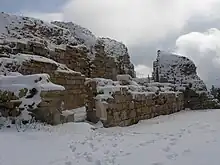Citadel of Safed
The Citadel of Safed is an ancient fortress castle. Situated on the peak of the mountain on which sits the old town of Safed. Archaeological evidence of a Caananite settlement were found there. Furthermore, fortifications existed during the late period of the Second Temple[1] as well as the Roman Empire.[2] However most of the remains left in the place are from the Crusader, Mamluk and Ottoman periods. The Citadel was an important administrative center of the Crusaders.[2] The citadel was severely damaged in the strong earthquake that struck Safed in 1837. During the last few decades, extensive archaeological excavations have been carried out at the site, revealing remains and ancient findings from all periods of the citadel's existence. Today, the citadel is visited by tourists for its historical value as well as the view (part of the citadel's historic strategic value), since due to its high location you can see from it the surroundings of Safed, from the Meron mountain massif in the west, the Sea of Galilee in the east, the lower Galilee in the south, and the Naftali and Hermon mountains to the north.[1] Around the citadel, the citadel garden was established in 1950, designed by landscape architect Shlomo Oren Weinberg. A memorial monument was erected to the Safed residents who lost their lives in the War for Israel's Independence.

מצודת צפת | |
 | |
| Coordinates | 32°58′04″N 35°29′43″E |
|---|---|
| History | |
| Cultures | Second Temple, Crusader, Mamluk |
| Architecture | |
| Architectural styles | Prominent: Gothic, Mamluk |
For further reading
- Denys Pringle, Reconstructing the Castle of Safad, Palestine Exploration Quarterly 117, (1985), pp. 139–49
- Denys Pringle, Safad, in Secular buildings in the Crusader Kingdom of Jerusalem: an archaeological Gazetteer, Cambridge University Press, (1997), pp. 91–92
Links to related articles
References
- Israel, Tourist (2012-05-30). "Safed Citadel (Tsfat)". Tourist Israel. Retrieved 2023-08-16.
- "Citadel (Metsuda)". Time Out Israel. 2017-08-21. Retrieved 2023-08-16.